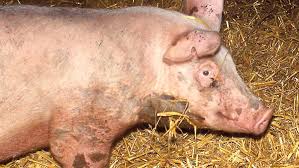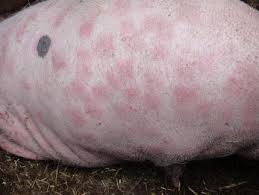Erysipelas in pigs (Swine Erysipelas) is an infectious disease caused by the bacterium Erysipelothrix rhusiopathiae seen mainly in growing pigs (all pigs over the age of 12 weeks) and characterized clinically by sudden death, fever, skin lesions and arthritis.
Erysipelas in pigs (Swine Erysipelas) can also be defined an infectious disease mostly of growing or adult swine. It may be clinically inapparent, may cause acute illness involving many animals, or be a chronic disease characterized by enlarged joints, lameness, and endocarditis. Rhomboid skin (diamond-skin) lesions are an inconsistent feature only associated with acute cases.
Up to 50% of pigs in intensive swine production areas are considered to be colonized with E rhusiopathiae. The organism commonly resides in the tonsillar tissue. This fever can induce abortion in pregnant gilts and sows.
These typical healthy carriers can shed the organism in their feces or oronasal secretions and are an important source of infection for other pigs. Infection is by ingestion of contaminated feed, water, or feces and through skin abrasions. When ingested, the organism can survive passage through the hostile environment of the stomach and intestines and may remain viable in the feces for several months.
On farms where the organism is endemic, pigs are exposed naturally to E rhusiopathiae when they are young. Maternal-derived antibodies provide passive immunity and suppress clinical disease.
Older pigs tend to develop protective active immunity as a result of exposure to the organism, which does not necessarily lead to clinical disease. Recovered pigs and chronically infected pigs may become carriers of E rhusiopathiae. Healthy swine also may be asymptomatic carriers.
Although pig farming business is one of the lucrative aspects of animal husbandry or production in agriculture (agricultural business often referred to as AgriBusiness), certain factors like diseases and others sometimes hinders the optimum performance of the pigs there by leading to loss to the pig farmer.
Regarding Erysipelas in pigs (Swine Erysipelas), stress factors such as overstocking, mixing pigs after weaning and sudden changes in temperature can trigger clinical erysipelas.
Environmental contamination is common because bacteria are excreted via saliva, nasal secretions, faeces, and urine. The bacteria can survive for weeks outside the pigs.
Read Also: The different types of pig feeds and when to feed each
Causes of Erysipelas in pigs (Swine Erysipelas)

- Wet dirty pens, particularly if they are heavily contaminated with faeces that contain high numbers of organisms.
- Wet feeding systems, particularly if milk by-products are used, can become major sources for multiplication of the organism.
- Continually populated houses with no all-in and all-out procedures and disinfection.
- Water systems that have become contaminated with the organism.
- Feed-back of faeces.
- The movement of pigs involving mixing and stress, particularly when maternal antibody from the sow is disappearing.
- Sudden changes in temperature and warm summer weather.
- During warm summer weather when pigs foul their pens.
- Sudden changes in diet.
- Common in straw based systems.
- Diets that contain fungal toxins (mycotoxins) particularly aflatoxin.
- Heavy parasite burdens or low levels of coccidia that allow the bacteria to enter through the damaged wall of the intestine.
- The purchase of non-vaccinated boars or gilts.
- Virus infections particularly PRRS and SI.
Clinical Signs of Erysipelas in pigs (Swine Erysipelas)

Possible clinical manifestations are cutaneous erythema, including characteristic diamond-shaped lesions, septicemia, arthritis, and endocarditis. Erysipelas is a common cause of carcass condemnation at abattoirs.
Diagnosis is by bacterial culture from fresh tissues, fluid, or blood or by molecular testing (ie, demonstration and identification of E rhusiopathiae).
According to research, the onset is sudden. Usually the disease is confined to two or three animals in any one outbreak although in the non-vaccinated herd 5 to 10 percent of animals could be affected any one time. Can be so mild that it goes unnoticed.
Sows
- Often the only sign is death due to an acute septicaemia or heart failure.
- Restricted blood supply causes small raised areas called diamonds in the skin. These are clearly defined become red and finally black, due to dead tissue but no abscesses. Most heal in 7–10 days.
- High temperatures 40°C (108°F; fever).
- Obviously ill (although some can appear normal).
- Often these lumps can be palpated in the early stages before anything can be seen.
- Stiffness or reluctance to rise indicating joint infection – arthritis.
- Inappetence.
- Infertility.
- Skin ulceration.
- The organism either affects:
- The joints producing lameness.
- The heart valves producing growths.
Boars
- Boars infected with erysipelas develop high temperatures and sperm can be affected for the complete development period of five to six weeks. Infertility is demonstrated by returns, sows not in pig and poor litter sizes.
The important effects of Erysipelas in pigs (swine erysipelas) on reproductive failure
- Sick animals with high fevers.
- Abortions during acute or sub-acute disease with ill sows and dead piglets.
- The death of piglets inside the womb and mummification.
- Abortions with decomposing piglets.
- Absorption of embryos and delayed returns.
- Normal returns if infection occurs immediately post-service.
- Variable litter size.
Weaners and growers
Commonly the disease is less acute and mild.
- Sudden death.
- Acutely ill pigs running high temperatures.
- Characteristic skin lesions may also be evident as large 10 to 50mm raised diamond shaped areas over the body that may turn from red to black. They may be easier to feel than to see in the early stages and often resolve over 7 to 10 days.
- Skin lesions may appear but the pigs may not appear to be ill in spite of a high temperature 42°C (107°F).
- The organism may settle in the joints causing chronic arthritis and swellings which can be responsible for condemnations at slaughter.
- Lameness.
Additionally, chronic (long term) changes can occur in pigs challenged with Erysipelas and present in 3 forms:
1) Endocarditis – the development of ‘cauliflower’ like lesions on heart valves that leads to death (often sudden) due to heart failure. Surviving pigs are likely to be condemned at slaughter. Other bacteria can cause such lesions (eg Strep suis).
2) Arthritis – a complicated form of the disease which can be very difficult to control. The difficulties arise because, in most cases, it is not the direct result of infection in joints with the organism. Erysipelas arthritis is what is termed as immune mediated or hypersensitivity reaction.
The most significant factor clinically is that because the arthritis results from an immune medicated condition, it is not necessarily the case that the acute form of the disease will be seen prior to it. Moreover, it can occur in partially immune animals (i.e. pigs that are already sensitized to the organism) and, thus, can even occur following prior vaccination.
3) Skin necrosis – developing in a similar way to the arthritic form in which ischaemic damage to the skin occurs, leading to death of the tissues and sloughing of the skin. It can lead to loss of extremities, especially the ears but also scrotum and any other areas
Read Also: Comprehensive Guide to Pig Farming Business for Profits
Diagnosis / Treatment of Erysipelas in pigs (Swine Erysipelas)
E rhusiopathiae is susceptible to beta-lactam antibiotics, and penicillin is the most commonly recommended treatment. Vaccines are generally effective in preventing acute disease.
This is determined by the clinical picture, with key features of:
- Inappetence.
- Very high temperature.
- Diamond shaped skin swellings – If the diamond markings are not obvious to the eye they can be felt if the hand is run over the skin of the back or behind the back legs and over the flanks.
Post-mortem and isolation of the organism will indicate disease, which is easy to grow in the laboratory. Serology will indicate exposure to the organism but it can only be used to confirm disease if rising titres, 14 days apart, are demonstrated.
The interpretation of titre levels (hemagglutination inhibition test):
- 1:4–1:64 due to vaccination.
- 1:32–1:320 suggests maternal antibody or exposure to the organism.
- 1:640 suggests previous infection.
- A rise in a titre level from 1:320 to 1:1280 would suggest active infection. Erysipelas may become a problem in herds where PRRS is endemic.
The bacterium alone can cause the disease but concurrent virus infections, such as PRRS or influenza, may trigger large outbreaks and this should be borne in mind in making a diagnosis.
Read Also: How to Set Up your New Pig Farm (Comprehensive Beginners Guide)
Read Also: What Is Agro Ecology? Everything You Need To Know

